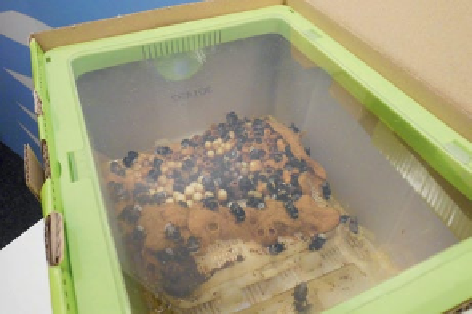Agriculture Reference
In-Depth Information
Fig. 10.19
Bumble bees,
ready for pollination applica-
tion in a greenhouse. (Source:
Gruda 2013, personal
archive)
tochemical quenching, indicating a lower energy dissipation in heat, compared to
non-pruned plants. The results related to chlorophyl-a fluorescence, indicate that
pruned plants have a higher capacity for better promoting a photosynthetic light
reaction than non-pruned plants (Calatayud et al.
2008b
).
In addition Cockshull and Ho (
1995
), found that tomato fruit production and
fruit size can be adjusted to the level of available photo-assimilates if cluster prun-
ing is coordinated with the growing period. The number of fruits (fruit load) as well
as the fruit to leaf ratio are important in fruit vegetables. Logendra et al (
2001
) re-
ported 25 % higher tomato yields at single-cluster plants pruned to allow two leaves
above the cluster than plants pruned directly above the cluster. Furthermore, both
fruit yield and harvest index were greater for all single-cluster plants at a higher
light level. According to Ho (
1992
) however since fruit constitute a major portion
of photo-assimiliates, the variation in number will influence their size rather than
the fruit to leaf ratio. On the other hand, according to Dorais et al. (
2001
) severe
deleafing of plants reduces photosynthetic capacity of the canopy and the remobili-
zation of mobile elements. Therefore, Slack (
1986b
) recommended that deleafing in
commercial tomato crops should not exceed the level of ripening fruits.
Pollination
For a range of greenhouse vegetables such as melons, pepper, tomato, eggplant,
zucchini, and strawberry, extra pollination is needed to assure good fruit setting
and productivity. Pollen quality can be adversely affected by high temperatures,
limited air movement and high humidity in greenhouses. Since most cucumber cul-
tivars are parthenocarpic they do not need extra pollination. Plant pollination can
be enhanced by using a mechanical (vibration) or biological method (e.g. bumble
bees, Fig.
10.19
). The latter used more frequently in greenhouses because they are
natural agents of pollination and growers benefit because of lower production costs,
increased yields, and improved fruit quality (Velthuis and van Doorn
2006
).

